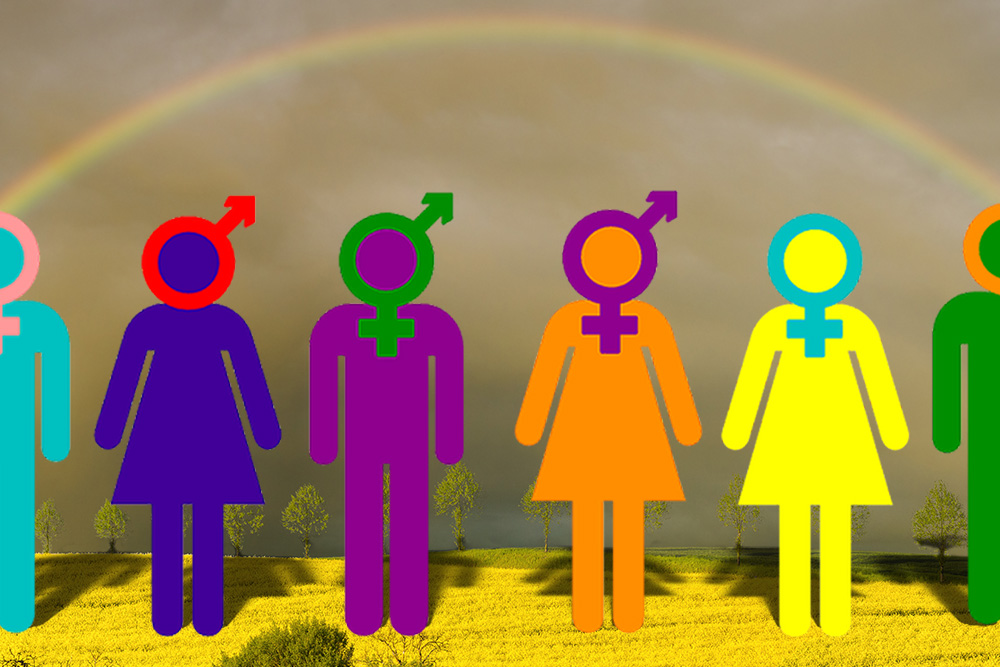First and foremost, we must recognize that every person struggling with gender-identity issues is our brother or sister; each one is an important member of our human family. They are to be loved, cherished, and are to receive our deepest sympathy, compassion, and concern. We must recognize that their struggles are real and their struggles are painful, soul-wrenching, and that these individuals will not be benefited by messages that are vilifying, condemning, mean-spirited, or devaluing of them as anything less than children of God.
Yet loving them does not mean we surrender our thinking to them. We must not allow those struggling with gender identity to determine our understanding of reality. We would not allow a blind person to tell us what a rainbow looks like, or a deaf person to tell us the difference between an owl’s hoot and the melody of a songbird. Likewise, we must not allow those struggling with gender identity to define human sexuality or gender for us. Their views are unavoidably flawed and inconsistent with God’s design—just like blindness and deafness unavoidably impair perception, create flawed views of reality, and are inconsistent with God’s design for human functioning.
But like blindness and deafness, the condition of transgenderism is not sin and does not warrant condemnation; it is a result of nature being damaged by sin (Romans 8:19, 20). And individuals struggling with any health problem deserve our understanding and compassion. We must not be like Jesus’ disciples who misunderstood reality and asked Him, “Who sinned that a man was born blind, him or his parents?” Jesus correctly answered that it was neither (John 9:2, 3). It is not sinful to have gender confusion—it is a terrible burden and such people desperately need our love, compassion, and support.
What is transgenderism?
Let’s first define what transgenderism is not; transgenderism is not gayness or lesbianism. Gay men are still men, and lesbian women are still women.
Transgenderism is also not one of the various intersex conditions. It is not:
- Hermaphrodism (a person with both male and female genitalia or gonads)
- Chimerism (a person with two cell lines XX and XY for instance)
- Mosaicism (a person with more than two sex chromosomes, such as XXXXY or XYY)
- Klinefelter syndrome (a person with two XXs and one Y)
- Turner’s syndrome (a person with only one X chromosome and no Y chromosome)
- Androgen insensitivity syndrome (a person with XY chromosome but with a defective gene coding for the testosterone receptor so that despite being genetically male they are born with female genitalia, raised female, and have female identity).
All of these conditions and others are termed “intersex” conditions, in which something is physiologically abnormal and contributes to the various syndromes.
Transgenderism is something new. It is the idea that a person without any biological intersex condition doesn’t psychologically feel like their physiological gender. A transgendered person will say they feel like a man in a woman’s body or they feel like a woman in a man’s body. They will say that their gender was “assigned” at birth as though their body is not actually male or female. Now, in some rare circumstances of the intersex conditions listed above, it is true that parents and doctors will assign a gender at birth to an infant born with ambiguous genitalia. But this is a rare circumstance and does not represent the vast majority of those who identify as transgendered. The vast majority of people identifying as transgendered typically do not have a biological intersex condition; instead, they have a psychological identity disturbance that centers on their gender.
It is unclear whether there is some yet-to-be-determined physiological abnormality contributing to transgenderism. Is it due to higher hydrocarbons in the environment? Is it due to estrogenic-inducing chemicals? Is it an impact of pesticides? Is it a result of polypharmacy during fetal development? Is it due to genetically modified foods? Is it a result of vaccines? Might there be some underlying neurodevelopmental abnormality yet to be identified?
These are legitimate questions, and some evidence warrants further investigation. Studies have found that the rate of gender confusion is up to ten times higher among those with Autism Spectrum Disorder than the general population; in one study within the autistic group, 5 percent had gender-identity issues, compared to 0.7 percent of the control group. Another study found the rate among the autistic population to be 7.8 percent.[1] So it is possible that there is some underlying neurobiological or other physiological abnormality that contributes to transgenderism. But even if a physiological explanation is never discovered, we must remain kind, loving, and compassionate in our dealing with transgendered people.
Yet we must not allow our compassion to cause us to accept transgenderism as a healthy state of being—it is not. Something is seriously wrong with those who struggle with gender confusion. Suicidal behavior among transgendered individuals is 32 to 50 percent,[2] which is 8 to 10 times higher than the general population (4 percent).[3] Transgendered individuals don’t just struggle with gender identity; they struggle with identity—they don’t know who they are and they are searching; thus, they have a higher rate of mental-health problems than the general population. A study published in JAMA found that 41.5 percent of transgendered women had some form of mental illness.[4] This is double the rate in the general population of 20.6 percent.[5]
Because transgendered individuals struggle with identity, having difficultly being at peace with themselves, they seek others to validate them, to reassure them, to affirm them as a way of compensating for their own self-dissatisfaction. (This is one reason that many members in the LGBTQ community aggressively put their sexuality on display in public settings, forcing society to respond to it.) Transgendered people really just want to be loved and accepted and, deep down, they don’t like the way they are. They want to be different than they are, and this is why they seek sex-reassignment surgery. This is why many of them want others to tell them that we agree with their views of gender. This is why some become outraged at anyone who doesn’t agree with their views. Indeed, some are so agitated that they seek, under the guise of social justice, to harm—financially, professionally, or legally—those who don’t validate their transgenderism.
But to normalize transgenderism is to fail to properly understand it and fail to seek real solutions that could one day eliminate the internal struggles and conflicts and bring real health and wellness. Long-term follow-up of transgendered individuals who received sexual reassignment surgery documented that gender dysphoria was reduced by the surgery but that mental-health problems persisted. The sex-reassigned individuals had higher rates of mental illness, psychiatric admissions, suicide attempts, and died by suicide at three times the rate of the control group.[6] This may be because gender confusion is only part of a larger mental-illness constellation that is not being understood properly because of social-normalization pressures.
Two Worldviews
In seeking to understand the struggles of the gender-confused, there are two general worldviews through which people process life and make assessments about reality: 1) a Creator worldview in which humans were made by God, 2) and a godless evolutionary worldview in which humans evolved over eons of time.
These worldviews necessarily impact how we understand and deal with questions like transgenderism. In the godless worldview, transgenderism will often be viewed as some element of evolutionary advancement of the species. Some environmental pressure is impacting the genome to cause humans to change. They will conclude there must be some adaptive or beneficial reason for transgenderism that will benefit the species and, thus, we should accept and support this change as a normal evolutionary process.
They will argue that it is counterproductive to consider transgenderism as abnormal or a health problem. The depression, suicidality, anxiety, addictions that are comorbid with transgenderism are recognized as mental-health problems but not transgenderism itself. They will argue that the problem for the transgendered is a judgmental and unaccepting society that causes the increased distress and related mental-health problems. With this perspective, they will seek to advance normalization of transgenderism, believing that if it were just accepted as a normal alternative to human sexuality, transgendered individuals would no longer have such high rates of mental illness.
This view is flawed because its base assumptions are wrong. Gender confusion is not normal; it is a symptom that something is abnormal. And individuals struggling with gender confusion are not at peace with themselves, nor society around them. Transgenderism is not consistent with God’s design for life and is, therefore, not healthy. In a creationist worldview, transgenderism is seen as any other malady afflicting the human species would be seen—be it blindness, deafness, sterility, muscular dystrophy, schizophrenia, etc. All maladies are deviations from God’s design for health and happiness. These conditions need treatment, not condemnation. People with these conditions need love, support, compassion, understanding, and the freedom to pursue whatever path toward health and happiness they desire. But happiness is a result of healthiness, and healthiness only occurs in harmony with God’s design laws for life.
We do a great disservice to people when we suggest that gender is fluid, that there is no male or female, that gender is just a mental construct and can be chosen, and that all forms of gender expression are equally healthy.
It would be foolish—worse, it would be destructive—to teach that because people born blind didn’t choose to be blind, we should recognize blindness as healthy and normal. While we must recognize the blind person as equal in worth and value, we must never consider blindness equal to good vision.
Likewise, when it comes to any intersex condition or confusion about gender, we must always consider the intersex or transgendered person to be equal in moral value and worth, but at the same time, we must never consider these conditions to be equal to God’s design for human sexuality. They are not.
And what matters in God’s kingdom is not gender but character. I would much rather work with a transgendered person who is honest, kind, loyal, reliable, trustworthy than a heterosexual liar, fraud, and cheat. Christians must not lose focus on the real issue—being reborn in heart and mind to love God and others more than self. Transgendered people can absolutely experience salvation and receive a new heart and right spirit while millions of heterosexuals never do.
From a biblical worldview, there are only two groups, the sheep and the goats, the wheat and the tares, the righteous and the wicked—not the heterosexual and transgendered. I am convinced the issues of worldly identity—race, ethnicity, gender—are irrelevant to determining eternal life; what is relevant is being reborn and having God’s law written on the heart and mind.
So think for yourself, don’t bow to social and political pressures, differentiate what is real from imagined, but always practice the principles of truth presented in love while leaving others free.
[1] Glidden, D., et al., Gender Dysphoria and Autism Spectrum Disorder: A Systematic Review of the Literature, Sexual Medicine Reviews, Volume 4, Issue 1, January 2016, Pages 3-14
Strang, J.F., Kenworthy, L., Dominska, A. et al. Increased Gender Variance in Autism Spectrum Disorders and Attention Deficit Hyperactivity Disorder, Arch Sex Behav (2014) 43: 1525. https://doi.org/10.1007/s10508-014-0285-3
de Vries, A., et al, Autism Spectrum Disorders in Gender Dysphoric Children and Adolescents J Autism Dev Disord. 2010 Aug; 40(8): 930–936.
[2] Virupaksha, H. G., et al., Suicide and Suicidal Behavior among Transgender Persons; Indian Journal of Psychological Medicine | Nov – Dec 2016 | Vol 38 | Issue 6, p. 505-509.
[3] https://www.samhsa.gov/data/sites/default/files/NSDUH-DR-FFR3-2015/NSDUH-DR-FFR3-2015.htm
[4] https://jamanetwork.com/journals/jamapediatrics/article-abstract/2504261
[5] https://www.nami.org/mhstats
[6] Dhejne, C., et al., Long-Term Follow-Up of Transsexual Persons Undergoing Sex Reassignment Surgery: Cohort Study in Sweden; Published: February 22, 2011. https://doi.org/10.1371/journal.pone.0016885









 using your credit or debit card (no PayPal account needed, unless you want to set up a monthly, recurring payment).
using your credit or debit card (no PayPal account needed, unless you want to set up a monthly, recurring payment). instead?
instead?